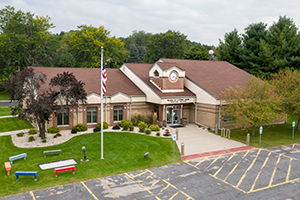
The Village of Cottage Grove is embarking on its inaugural public arts strategy to enrich community engagement, commemorate its centennial, and foster cultural vitality. Employing a mixed-method approach, the project entails qualitative interviews and quantitative surveys targeting 250 respondents, representing 2.5% of the village’s population. These methods help gauge public art preferences and perceptions among […]
Read More… from Developing a public art strategy for the Village of Cottage Grove

This roadway redesign project addresses Cottage Grove’s goals to develop a corridor that maintains traffic operations while increasing multimodal accessibility and considering future growth in the area. Plans included measures to calm traffic, improve bicycle and pedestrian safety, and address parking, transit, and streetscaping. UniverCity Contact Info: UniverCityAlliance@wisc.edu […]
Read More… from Exploring design options for West Cottage Grove Road

Between 2010 and 2021, the city of Marinette, Wisconsin realized a 2% increase in the proportion of the population in the workforce (US Census Bureau, 2019). Of the 10,701 people who work in Marinette, about 75 percent (8,063 people) commute into the city from other areas such as Menominee and Peshtigo (Bay Lake Regional Planning […]
Read More… from Improving housing options for the next generation of Marinette residents

This project reviewed St. Croix County Jail policies related to access to health care, emergency health scare, medical screening, mental health services, and suicide prevention and intervention and offered recommendations to improve the health and wellbeing of those housed in the facility. UniverCity Contact Info: UniverCityAlliance@wisc.edu […]
Read More… from Mapping and reviewing St. Croix County Jail health care policies for inmates

In the landmark case, Estelle v Gamble (1976), the right of health care for inmates was established (Rosenfeld, 2016). In this case, Gamble, the inmate, was injured while working for the prison. He was not given adequate treatment which then led to further complications. This case argued that the lack ofhealth care for Gamble was […]
Read More… from Reviewing Carceral Health Care Obligations in Wisconsin

Maintaining a stable residence in sober living housing (SLH) for at least six months or more sustains positive outcomes related to substance abstinence, contact with the criminal legal system, psychiatric symptoms, depression, and more (Subbaraman et al. 2023). Jason and Ferrari (2010) found that those who sought alternative care options used substances at over twice […]
Read More… from Identifying best practices for sober living housing (SLH) in St. Croix County

National data has shown that sober living facilities can aid in promoting recovery for women with co-occurring domestic violence and substance-use disorders using tangible resource attainment (e.g., food, clothing, shelter) and emotional support (Edwards et al., 2017). A community assessment conducted by the Community Justice Collaborating Council (CJCC) of St. Croix County has identified a […]
Read More… from Creating a sober living facility for women involved in the justice system in St. Croix County

Substance use disorder (SUD) is a major public health concern in St. Croix County, Wisconsin. Last year, there were 419 emergency room visits related to chronic alcohol use (Wisconsin Department of Health Services, 2022a), and 22 visits related to opioid overdose (Wisconsin Department of Health Services, 2022b). According to St. Croix County’s treatment court coordinator, […]
Read More… from Improving wraparound substance use treatment for St. Croix County treatment court participants

Wood County Health Department has identified disparities in community health outcomes as a priority consideration for current and future programming. Wood County is home to almost 75,000 individuals, many of whom belong to marginalized groups. The Hmong community, Latinx/e community, Ho-Chunk Nation, and the Amish community are of particular concern to the Health Department in […]
Read More… from Evaluating Health Equity of Programs in Wood County



